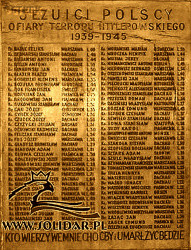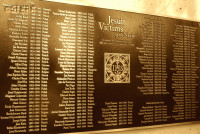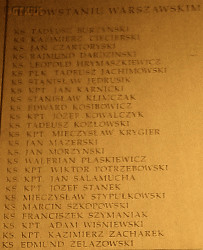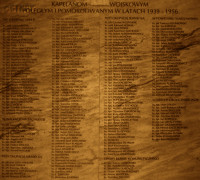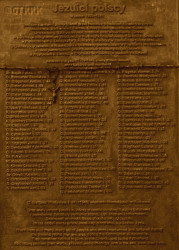Roman Catholic
St Sigismund parish
05-507 Słomczyn
85 Wiślana Str.
Konstancin deanery
Warsaw archdiocese, Poland
full list:
displayClick to display full list

searchClick to search full list by categories
wyświetlKliknij by wyświetlić pełną listę po polsku

szukajKliknij by przeszukać listę wg kategorii po polsku

Martyrology of the clergy — Poland
XX century (1914 – 1989)
personal data
surname
KOSIBOWICZ
forename(s)
Edward John (pl. Edward Jan)
function
religious cleric
creed
Latin (Roman Catholic) Church RCmore on
en.wikipedia.org
[access: 2014.09.21]
congregation
Society of Jesus SImore on
en.wikipedia.org
[access: 2014.09.21]
(i.e. Jesuits)
diocese / province
Lesser Poland Province SI (from 1926)
Polish Province SI (1918‐1926)
Galicia Province SI (till 1918)
RC Military Ordinariate of Polandmore on
en.wikipedia.org
[access: 2014.12.20]
academic distinctions
Doctor of History
date and place
of death
02.08.1944

Warsawtoday: Warsaw city pov., Masovia voiv., Poland
more on
en.wikipedia.org
[access: 2021.10.09]
details of death
On 09.07.1928, by order of the President of the Republic of Poland, appointed reserve chaplain of the Polish Army, with seniority from 01.03.1928 and 10th place among the military Roman Catholic clergy, in the rank of captain (for a statutory 2‐year period).
In 1939 nominated state of war chancellor of Military Ordinariate of Poland. After German and Russian invasion of Poland in 09.1939 and start of the World War II and fall of Poland did not however manage to take up this position.
During German occupation collaborated with Polish clandestine resistance organizations (part of Polish Clandestine State).
Among others under his auspices clandestine ethics lectures for young prospective medicine doctors were run.
Organised clandestine theology stadium for Jesuit clerics in Warsaw where lecturer on dogmatic theology.
His last Lenten retreat preached in Warsaw in 03.1944 was published after the end of the armed conflict, in 1947, under the title „Christianus sum!”.Murdered by the Germans on the second day of Warsaw Uprising — executed by a shot into the back of the head, n. the gardens of Mokotowskie Fields, a part of the mass murder of Jesuits in their Congregation's house at Rakowiecka Str. in Warsaw.
cause of death
mass murder
perpetrators
Germans
sites and events
Warsaw (Jesuit monastery, Rakowiecka st.)Click to display the description, Warsaw UprisingClick to display the description, GeneralgouvernementClick to display the description, Ribbentrop‐MolotovClick to display the description, Pius XI's encyclicalsClick to display the description
date and place
of birth
13.12.1895Birth certification on:
photos.szukajwarchiwach.gov.pl
[access: 2025.08.19]

Nowy Sącztoday: Nowy Sącz pov., Lesser Poland voiv., Poland
more on
en.wikipedia.org
[access: 2021.04.01]
parents
KOSIBOWICZ Francis
🞲 ?, ? — 🕆 ?, ?

MICZULSKA Agnes
🞲 ?, ? — 🕆 ?, ?
baptism
22.12.1895Birth certification on:
photos.szukajwarchiwach.gov.pl
[access: 2025.08.19]

Nowy Sącztoday: Nowy Sącz pov., Lesser Poland voiv., Poland
more on
en.wikipedia.org
[access: 2021.04.01]
St Margaret the Virgin and Martyr RC church
presbyter (holy orders)
ordination
24.08.1923

Ore PlaceHastings
today: non‐existent manor house, East Sussex Cou., England, United Kingdom
more on
en.wikipedia.org
[access: 2021.12.18]
RC chapelmore on
en.wikipedia.org
[access: 2021.12.18] (in Theological College)
positions held
1936 – 02.08.1944
superior — Warsawtoday: Warsaw city pov., Masovia voiv., Poland
more on
en.wikipedia.org
[access: 2021.10.09] ⋄ monastery („Writers' House”, 61 Rakowiecka Str.), Jesuits SI
from 1936
director — Warsawtoday: Warsaw city pov., Masovia voiv., Poland
more on
en.wikipedia.org
[access: 2021.10.09] ⋄ printing house, Jesuits SI
1936 – 1939
Editor in Chief — editorial office, „General Review” monthly
1929 – 1936
friar — Krakówtoday: Kraków city pov., Lesser Poland voiv., Poland
more on
en.wikipedia.org
[access: 2021.06.07] ⋄ St Barbara monastery, Jesuits SI — also: chaplain at the Neurological and Psychiatric Clinic of the Jagiellonian University
till 1936
lecturer — Krakówtoday: Kraków city pov., Lesser Poland voiv., Poland
more on
en.wikipedia.org
[access: 2021.06.07] ⋄ Department of Theology, College (Lat. Collegium Maximum SS. Cordis Iesu, 26 Kopernik Str.), Jesuits SI — i.a. philosophical anthropology
1929 – 1936
Editor in Chief — editorial office, „Sodalis Marianus” monthly
1929 – 1936
Editor in Chief — editorial office, „Faith and Life” magazine
1925 – 1928
PhD student — Enghientoday: Ath mun., Hainaut prov., Wallonia reg., Belgium
more on
en.wikipedia.org
[access: 2022.08.28] ⋄ comparative history of religions, Higher Theological Institute, Jesuits SI — also: chaplain to Polish emigrants and migrants
1924 – 1936
associate — editorial office, „General Review” monthly
1920 – 1924
student — Ore PlaceHastings
today: non‐existent manor house, East Sussex Cou., England, United Kingdom
more on
en.wikipedia.org
[access: 2021.12.18] ⋄ theology, Theological College (theologate), Jesuits SI
friar — Nowy Sącztoday: Nowy Sącz pov., Lesser Poland voiv., Poland
more on
en.wikipedia.org
[access: 2021.04.01] ⋄ Descent of the Holy Spirit (Pentecost) monastery, Jesuits SI
friar — Bunkovychin .Khyriv
today: Khyriv urban hrom., Sambir rai., Lviv obl., Ukraine
more on
uk.wikipedia.org
[access: 2022.11.09] ⋄ monastery, St Joseph College („Khyriv” Scientific and Educational Institute), Jesuits SI
friar — Stara Wieśtoday: Brzozów gm., Brzozów pov., Subcarpathia voiv., Poland
more on
en.wikipedia.org
[access: 2021.12.18] ⋄ Assumption of the Blessed Virgin Mary monastery, Jesuits SI
from 01.09.1909
novitiate — Stara Wieśtoday: Brzozów gm., Brzozów pov., Subcarpathia voiv., Poland
more on
en.wikipedia.org
[access: 2021.12.18] ⋄ Assumption of the Blessed Virgin Mary monastery, Jesuits SI
author of i.a. „Christianus sum! The last Lenten retreat preached in Warsaw in March 1944”, Warszawa 1947; „The problem of immorality. Hedonism or Jansenism?”, Warszawa 1938; „The fight for the Catholic school”, Kraków 1937; „The plague of immorality”, Kraków 1935; „The Problem of the Pygmy Peoples”, Kraków 1927; and many articles, translations, reviews and longer studies in „General Review” and „Faith and Life”
others related
in death
BAJAKClick to display biography Felix, BIEGAŃSKIClick to display biography Anthony, BOBRITZKIClick to display biography Clement, FUSClick to display biography Joseph, GŁAUDANClick to display biography Adam, GRABOWSKIClick to display biography Zbigniew, LIBIŃSKIClick to display biography Herman, MADALIŃSKIClick to display biography John, ORZECHOWSKIClick to display biography Stanislav, PAWELSKIClick to display biography John, SZYMANIAKClick to display biography Francis, ŚWIĘCICKIClick to display biography Ceslav, TOMASZEWSKIClick to display biography Stanislav, WIĄCEKClick to display biography Vladislav, WILCZYŃSKIClick to display biography Henry, WRÓBLEWSKIClick to display biography Mieczyslav Felix
sites and events
descriptions
Warsaw (Jesuit monastery, Rakowiecka st.): On 02.08.1944, the second day of Warsaw Uprising Germans, murdered in the Jesuit monastery in Warsaw on Rakowiecka Str. 44 people, including 16 Jesuits. Most of them died in a basement pelted with grenades and machine‐gun bullets. After the atrocity Germans doused the bodies with gasoline and set fire on them. (more on: www.info-pc.home.plClick to attempt to display webpage
[access: 2021.12.19])
Warsaw Uprising: Lasted from 01.08.1944 till 03.10.1944. Was an attempt to liberate Polish capital from occupying Germans by the Polish Clandestine State — a unique in the history of the world political structure on the territories occupied by the Germans, effectively governing clandestinely in Poland — and by fighting on its behalf underground military units, mainly of Home Army (former Armed Struggle Association ZWZ) and National Armed Forced (NSZ). At the same time Russians stopped on purpose the offensive on all front, halted on the other bank of Vistula river and watched calmly the annihilation of the city, refusing even the mid‐landing rights to the Allied planes carrying weapons and supplies to the insurgents from Italy. During the Uprising Germans murdered approx. 200,000 Poles, mainly civilians. Approx. 200 priests and nuns died in fighting or were murdered by the Germans, many in mass executions. (more on: en.wikipedia.orgClick to attempt to display webpage
[access: 2013.08.17])
Generalgouvernement: After the Polish defeat in the 09.1939 campaign, which was the result of the Ribbentrop‐Molotov Pact and constituted the first stage of World War II, and the beginning of German occupation in part of Poland (in the other, eastern part of Poland, the Russian occupation began), the Germans divided the occupied Polish territory into five main regions. In two of them new German provinces were created, two other were incorporated into other provinces. However, the fifth part was treated separately, and in a political sense it was supposed to recreate the German idea from 1915 (during World War I, after the defeat of the Russians in the Battle of Gorlice in 05.1915) of creating a Polish enclave within Germany. Illegal in the sense of international law, i.e. Hague Convention, and public law, managed by the Germans according to separate laws — especially established for the Polish Germ. Untermenschen (Eng. subhumans) — till the Russian offensive in 1945 it constituted part of the Germ. Großdeutschland (Eng. Greater Germany). Till 31.07.1940 formally called Germ. Generalgouvernement für die besetzten polnischen Gebiete (Eng. General Government for the occupied Polish lands) — later simply Germ. Generalgouvernement (Eng. General Governorate), as in the years 1915‐1918. From 07.1941, i.e. after the German attack on 22.06.1941 against the erstwhile ally, the Russians, it also included the Galicia district, i.e. the Polish pre‐war south‐eastern voivodeships. A special criminal law was enacted and applied to Poles and Jews, allowing for the arbitrary administration of the death penalty regardless of the age of the „perpetrator”, and sanctioning the use of collective responsibility. After the end of the military conflict of the World War UU, the government of the Germ. Generalgouvernement was recognized as a criminal organization, and its leader, governor Hans Frank, guilty of war crimes and crimes against humanity and executed. (more on: en.wikipedia.orgClick to attempt to display webpage
[access: 2024.12.13])
Ribbentrop‐Molotov: Genocidal Russian‐German alliance pact between Russian leader Joseph Stalin and German leader Adolf Hitler signed on 23.08.1939 in Moscow by respective foreign ministers, Mr. Vyacheslav Molotov for Russia and Joachim von Ribbentrop for Germany. The pact sanctioned and was the direct cause of joint Russian and German invasion of Poland and the outbreak of the World War II in 09.1939. In a political sense, the pact was an attempt to restore the status quo ante before 1914, with one exception, namely the „commercial” exchange of the so‐called „Kingdom of Poland”, which in 1914 was part of the Russian Empire, fore Eastern Galicia (today's western Ukraine), in 1914 belonging to the Austro‐Hungarian Empire. Galicia, including Lviv, was to be taken over by the Russians, the „Kingdom of Poland” — under the name of the General Governorate — Germany. The resultant „war was one of the greatest calamities and dramas of humanity in history, for two atheistic and anti‐Christian ideologies — national and international socialism — rejected God and His fifth Decalogue commandment: Thou shall not kill!” (Abp Stanislav Gądecki, 01.09.2019). The decisions taken — backed up by the betrayal of the formal allies of Poland, France and Germany, which on 12.09.1939, at a joint conference in Abbeville, decided not to provide aid to attacked Poland and not to take military action against Germany (a clear breach of treaty obligations with Poland) — were on 28.09.1939 slightly altered and made more precise when a treaty on „German‐Russian boundaries and friendship” was agreed by the same murderous signatories. One of its findings was establishment of spheres of influence in Central and Eastern Europe and in consequence IV partition of Poland. In one of its secret annexes agreed, that: „the Signatories will not tolerate on its respective territories any Polish propaganda that affects the territory of the other Side. On their respective territories they will suppress all such propaganda and inform each other of the measures taken to accomplish it”. The agreements resulted in a series of meeting between two genocidal organization representing both sides — German Gestapo and Russian NKVD when coordination of efforts to exterminate Polish intelligentsia and Polish leading classes (in Germany called «Intelligenzaktion», in Russia took the form of Katyń massacres) where discussed. Resulted in deaths of hundreds of thousands of Polish intelligentsia, including thousands of priests presented here, and tens of millions of ordinary people,. The results of this Russian‐German pact lasted till 1989 and are still in evidence even today. (more on: en.wikipedia.orgClick to attempt to display webpage
[access: 2015.09.30])
Pius XI's encyclicals: Facing the creation of two totalitarian systems in Europe, which seemed to compete with each other, though there were more similarities than contradictions between them, Pope Pius XI issued in 03.1937 (within 5 days) two encyclicals. In the „Mit brennender Sorge” (Eng. „With Burning Concern”) published on 14.03.1938, condemned the national socialism prevailing in Germany. The Pope wrote: „Whoever, following the old Germanic‐pre‐Christian beliefs, puts various impersonal fate in the place of a personal God, denies the wisdom of God and Providence […], whoever exalts earthly values: race or nation, or state, or state system, representatives of state power or other fundamental values of human society, […] and makes them the highest standard of all values, including religious ones, and idolizes them, this one […] is far from true faith in God and from a worldview corresponding to such faith”. On 19.03.1937, published „Divini Redemptoris” (Eng. „Divine Redeemer”), in which criticized Russian communism, dialectical materialism and the class struggle theory. The Pope wrote: „Communism deprives man of freedom, and therefore the spiritual basis of all life norms. It deprives the human person of all his dignity and any moral support with which he could resist the onslaught of blind passions […] This is the new gospel that Bolshevik and godless communism preaches as a message of salvation and redemption of humanity”… Pius XI demanded that the established human law be subjected to the natural law of God , recommended the implementation of the ideal of a Christian state and society, and called on Catholics to resist. Two years later, National Socialist Germany and Communist Russia came together and started World War II. (more on: www.vatican.vaClick to attempt to display webpage
[access: 2023.05.28], www.vatican.vaClick to attempt to display webpage
[access: 2023.05.28])
sources
personal:
adonai.plClick to attempt to display webpage
[access: 2012.11.23], college.holycross.eduClick to attempt to display webpage
[access: 2012.11.23], photos.szukajwarchiwach.gov.plClick to attempt to display webpage
[access: 2025.08.19], www.info-pc.home.plClick to attempt to display webpage
[access: 2021.12.19], www.sacerdospolonus.plClick to attempt to display webpage
[access: 2014.08.14], archive.todayClick to attempt to display webpage
[access: 2021.12.19], pl.wikipedia.orgClick to attempt to display webpage
[access: 2013.10.05]
bibliographical:
„Jesuits on Polish and Lithuanian territory knowledge encyclopedia, 1564‐1995”, Fr Louis Grzebień SI (editor), WAM Printing House, Cracow 1996
original images:
jezuici.plClick to attempt to display webpage
[access: 2024.12.13], www.katarzynamaciejewska.euClick to attempt to display webpage
[access: 2018.02.15], www.youtube.comClick to attempt to display webpage
[access: 2021.12.19], www.sowiniec.com.plClick to attempt to display webpage
[access: 2016.03.14], college.holycross.eduClick to attempt to display webpage
[access: 2013.05.19], www.katedrapolowa.plClick to attempt to display webpage
[access: 2014.01.16], www.miejscapamiecinarodowej.plClick to attempt to display webpage
[access: 2014.05.09]
LETTER to CUSTODIAN/ADMINISTRATOR
If you have an Email client on your communicator/computer — such as Mozilla Thunderbird, Windows Mail or Microsoft Outlook, described at WikipediaPatrz:
en.wikipedia.org, among others — try the link below, please:
LETTER to CUSTODIAN/ADMINISTRATORClick and try to call your own Email client
If however you do not run such a client or the above link is not active please send an email to the Custodian/Administrator using your account — in your customary email/correspondence engine — at the following address:

giving the following as the subject:
MARTYROLOGY: KOSIBOWICZ Edward John
To return to the biography press below:
 Click to return to biography
Click to return to biography














